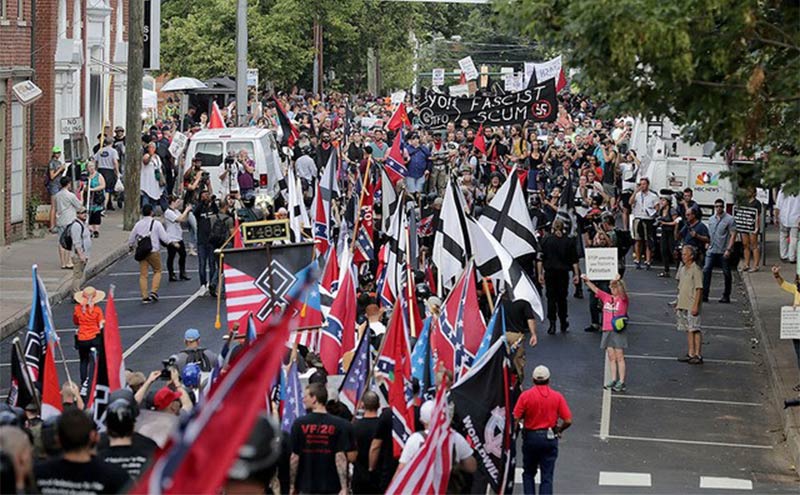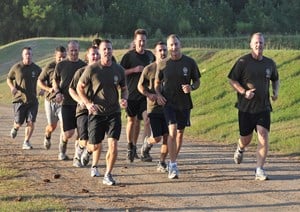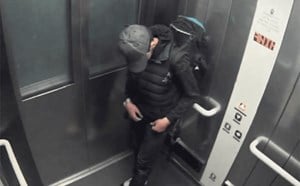
Lessons Learned from the “Unite the Right Rally” of 2017
On August 12, 2017, the city of Charlottesville, Virginia, experienced the “Unite the Right Rally”, an event organized by a variety of right wing and white supremacist groups to protest the proposed removal of a statue of Confederate General Robert E. Lee from a downtown Charlottesville Park while also serving as a call to action and unity for the white supremacist movement in the United States. The Rally was a deeply traumatic event for the City of Charlottesville, resulting in the death of one counter-protester and the serious injury of many others when a car was driven into a crowd of counter-protesters, and the accidental death of two Virginia State Police Troopers monitoring the event. The events of that day still reverberate locally and continue to influence the local, national, and even international perspective and conversation on the deeper issues involved. As we approach the fourth anniversary of the Rally current events have illustrated that many of the lessons learned in the planning, execution, and assessment of the fire and emergency medical services (EMS) operations that day remain relevant and may be helpful as we confront future challenges.
One of the first lessons learned is that the planning for this type of an event is primarily a law enforcement operation. Early planning meetings and briefings for the Rally saw a dozen or so fire/rescue uniforms in a large room filled with law enforcement officers. That is not to say that law enforcement officials will be difficult to work with or that they will not appreciate the role of fire/rescue resources in the event, both for the public and for their role in force protection, but it may take some effort and attention to keep fire/rescue needs and goals visible and prioritized. It is also worth keeping in mind that there may be a surprising number of law enforcement agencies involved in the planning and execution of the event, from local to state and even federal agencies, and that priorities may differ somewhat and communication may be challenging at times. Local government may also look primarily to law enforcement in their communications and to address their priorities and anxieties for the event. The corollary to this observation is that the public perceptions of the event will be primarily influenced by the interactions between the public, political leadership, protesters and counter-protesters, and law enforcement; sometimes it is good to be the fire chief. On the day of the Rally fire/rescue providers made an effort to be visually distinct from law enforcement, using brightly colored polo shirts color coded for tasks, and avoiding badges or other uniform components that might cause confusion in the eyes of those needing medical assistance, some of whom were wary if not antagonistic toward law enforcement.
Many of us have experience in preparing for mass gathering operations of various sizes and purposes but participating in the Unite the Right Rally turned out to be different in many ways. In many, if not most, mass gathering operations the attendees are generally there to enjoy a shared activity – they generally share similar goals and expectations for the experience. Planning can focus on somewhat predictable challenges, many of which can be based on past experience, e.g., heat illness or the “over-beveraged” spectator, and what could be referred to as the “expected unexpected” in large groups of people such as the significant fall or the STEMI. It became clear as we approached the day of the Rally that we were dealing with an event that would include many different groups with wildly different opinions and expectations for the event and for which we had little base of experience upon which to design our response other than our generic mass gathering experience. We also had very little information about what the actual size of the event would be. The permitted protesters had applied for a specific number of participants, but it was clear that many more of their supporters would attend and there was virtually no information about counter-protesters, keeping in mind that all of the groups involved did not want authorities to have an accurate idea of how many of their supporters would be present. Finally, we did not have any collective experience with a mass gathering event where the attendees expected, planned for, and even sought, conflict. We realized that the resources required for an event such as the Rally were several times what might be anticipated for a typical mass gathering event of similar numbers, but it was very difficult to accurately estimate what would be needed.
The physical environment of the Rally presented challenges as well. At the time, city ordinances and state laws were interpreted as constraining the ability of the city to disapprove or limit a permit for an assembly that had been legally applied for, therefore prohibiting a protest in the park or moving the Rally to a more removed area was problematic. The park where the Lee statue stood, then known as Lee Park, was a small area in downtown Charlottesville (almost exactly one acre) very close to both quiet residential areas to the north and the city’s commercial center to the south. It became clear that if a large group crossed pre-established lines or pushed through barriers they could overrun initial extraction and treatment areas very quickly. Therefore a system of pre-planned, staged fallback areas were established. As the Rally unfolded front line teams fell back very quickly to more secure areas already equipped to treat and transport patients. The small area and extreme congestion made movement across even short distances very difficult in some cases and necessitated multiple de-centralized teams across the downtown area using multiple pathways for ingress and egress.
One of the groups that participated in the Rally that we had no previous experience with were the “Street Medics”. The Street Medic movement appears to have roots that extend to the anti-war demonstrations of the 1960’s and was re-kindled during the “Occupy” movement of 2011 and 2012. The movement is very loosely organized, but media sources mention the goal of supporting protesters who were the victims of “activist-specific” injuries in areas where EMS response might be delayed. Mention is made of injuries due to “police violence” and the health effects of riot control measures such as tear gas and pepper spray that are “not understood” by the medical establishment. In the hours before the Rally EMS providers made efforts to interact with Street Medics to offer assistance and cooperation, many of whom were receptive and cordial but some who actively declined any assistance from fire/rescue providers as representatives of the “government.”
Another unanticipated circumstance was the realization that treatment areas needed to be designed to accommodate patients who could not be in close proximity to one another due to intense antagonism and the risk of further conflict. We were able to quickly separate treatment areas as well as entrance/exit zones to minimize contact between protesters and counter-protesters. Additionally, many of the victims of violence treated by fire/rescue providers and at aid-stations declined care beyond basic wound care and dressings, or never presented for care at all and thus were never included in treatment or triage logs, making a true estimate of the number and type of injuries almost impossible.
Fire/rescue providers were surprised to see the number of weapons that were displayed during the Rally. The Commonwealth of Virginia is considered an “open carry” state, that is, generally speaking if a citizen can legally possess a firearm they can openly carry that firearm, i.e., not concealed from view, unless local prohibitions are in place. A large number of handguns and rifles were present at the Rally, many carried by right-wing protesters and some by militia groups who claimed they were there to provide security for the event and demonstrate their commitment to second amendment rights. Obviously it was unclear how many concealed weapons were present in the crowd as well. Many of the militia members carried rifles and wore fatigue style clothing that made quick differentiation between protesters and law enforcement challenging. Luckily only one shot was fired during the Rally, without injury, but the number of weapons was a significant source of stress for providers and law enforcement and a reminder about how quickly the situation could dramatically escalate. Since 2017 both local ordinance and state law have evolved to give localities more authority to limit the presence of firearms at certain events and locations.
An observation made during Charlottesville’s KKK demonstration of July 2017 was the surprising amount of real-time data available from within the demonstration, out of direct observation by law enforcement and fire/rescue providers. Given the number of smart phones and other video recording devices with the ability to directly stream to the internet, monitoring of social networking platforms provided real-time video and sound streamed from within the demonstration that was very valuable in gauging the tenor and mood of the demonstration, as well as providing some advance warning of events unfolding that could impact the management of the situation.
Communication between field EMS units and the primary receiving hospitals was also challenging in some respects. The University of Virginia Hospital, a large teaching hospital and Level I trauma center, in partnership with the Sentara Martha Jefferson Hospital, a community hospital in Charlottesville, stood up a very robust response plan that very effectively managed a sudden burst of significantly injured patients when a car was driven into a crowd of counter-protesters. However, it quickly became clear that the terminology used in pre-hospital triage strategies such as START and SALT, (red, yellow, green and black) did not directly translate to trauma center alert criteria based on physiologic, anatomic, and mechanistic criteria. Although an EMS priority “red” might translate easily to an upper-level trauma team alert, an “alpha” alert in our system, an EMS priority “yellow” patient was difficult to match to a trauma team response level in the ED. This disconnect was particular challenging for EMS providers from other localities who participated as part of an EMS task force that augmented local resources but were not familiar with the local EMS system and our local trauma triage system. Although the patients were effectively managed, recognition of this conflict in terminology beforehand could have prevented some confusion and delay in communication.
Finally, it is difficult to over-estimate the effect of that day on the community and the fire/rescue and law enforcement personnel involved. Although there was a considerable amount of time available to plan logistically for the event, the personal impact of a day filled with so much anger and violence in the providers’ backyard is almost impossible to anticipate. The Rally and the violence involved, particularly the death and injuries involved when a protester intentionally drove into a crowd of pedestrians closely followed by the crash of a Virginia State Police helicopter and the death of the two crew members, left a lasting mark on all of those exposed. Although there were some important lessons learned in the management of such an event, it is accurate to say that the community of Charlottesville will never look at itself in quite the same way again and that all of those who served that day will consider themselves forever changed.
Corresponding Author:
George Lindbeck, MD, FACEP, FAEMS
Associate Professor of Emergency Medicine
Department of Emergency Medicine
University of Virginia School of Medicine
Email
No significant conflicts to declare.



